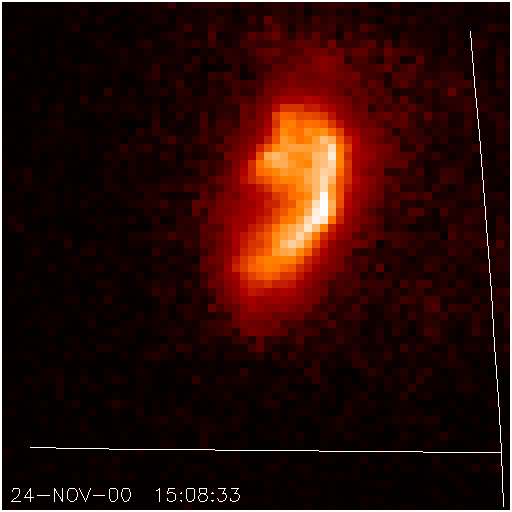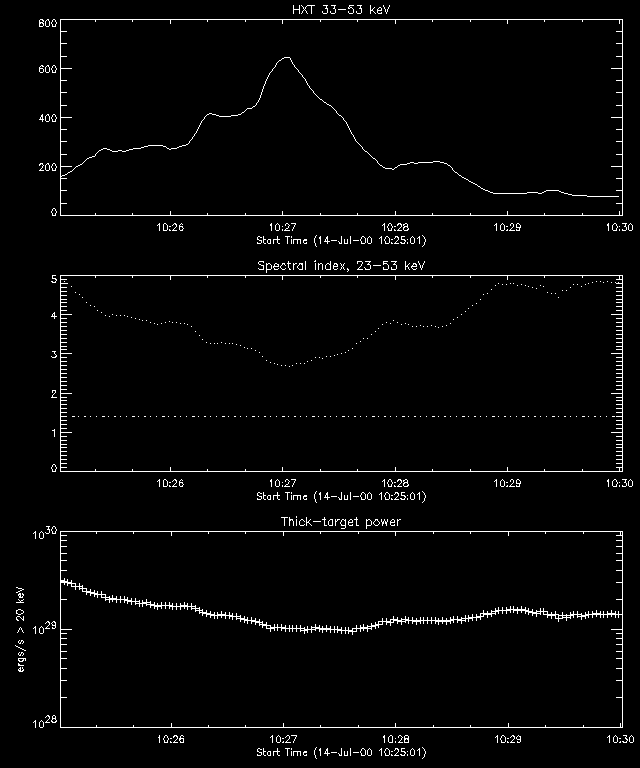 |
 |
As we get closer to the launch of HESSI (it almost happened this week!), naturally our thoughts turn to the high-energy aspects of solar flares. The solar hard X-rays and gamma rays give us quite direct views of non-thermal effects. The difference between thermal and non-thermal is kind of a cultural as well as a physical divide, apparently, but the distinction is easy: "thermal" means that the particle distributions in velocity and direction can be described by a single thermodynamic variable, the "temperature". This happy state results when collisions are numerous. Everything else is "non-thermal". The radiation field can also be in thermal equilibrium with the matter, but in a medium like our solar corona, we typically have the situation that the radiation is decoupled from the matter - in the sense of being highly directional, the radiation is almost always therefore highly non-thermal even if the spectra look thermal enough to analyze that way.
Heretofore (ie, prior to the arrival of Yohkoh's Hard X-ray Telescope), we had to deal with the solar hard X-ray spectrum as we would deal with any other star's: in integrated sunlight, without reference to the nature of the emitting structures. These early observations showed a characteristic pattern (but not a unique one): the soft-hard-soft signature. This describes a relationship between the hard X-ray flux and spectrum: the brighter the source, the harder the spectrum.
Much has changed observationally. We now can make images of flares, both in the thermal radiations (soft X-rays) and also in the non-thermal radiations (hard X-rays and microwaves). In this nugget we ask the following question: do flares of different types tend to show the soft-hard-soft pattern? We have selected two very different X-class flare events, as illustrated in the images below:
 |
 |
These images don't do justice to the differences between these events. The one on the left was a compact, impulsive, short-lived flare; the one on the right (see the topical index under "Bastille Day") was a lovely large and regular long-decay event.
Similar things, it turns out. The plots below show that each exhibits the "soft-hard-soft" pattern of spectral evolution in the hard X-ray range:
 |
 |
The top panel in each plot shows the hard X-ray flux (33-53 keV); the center panel shows the ratio of this to the 23-33 keV flux expressed as a power-law index. It's easy to see that as the flux goes up and down, this spectral index goes down and up. In our jargon a steep spectrum is "soft" and a flat spectrum "hard", thus "soft-hard-soft", a pattern first noted in the 1960's by S. Kane. It is getting reasonably technical now, but we can use the combination of image and spectrum to do a quantitative (but simple) physical analysis of each event:
Nov. 24, 2000 |
July 14, 2000 |
One is reminded, of course, of Mark Twain's "wholesale return of conjecture for a trifling investment in fact," but that would be wrong. We are learning solid things here about how much energy these electrons carry, and it is of the greatest importance since we don't know where they come from or why. It was a suprise, for example, that these two different events wound up having similar gas pressures.
We see that in these disparate events, with modern data, the soft-hard-soft pattern Kane noted prevails. In fact, it is almost (but interestingly, not exactly) ubiquitous. Its interpretation is simple: the more intense the energy release, the higher the particle energy. In other words, the mechanism for non-thermal particle acceleration - unknown to us still in spite of these much better data - tends to work with a fixed number of particles. If more energy needs to be released, it simply accelerates them to higher energies and makes a "hard" spectrum.
June 4, 2001